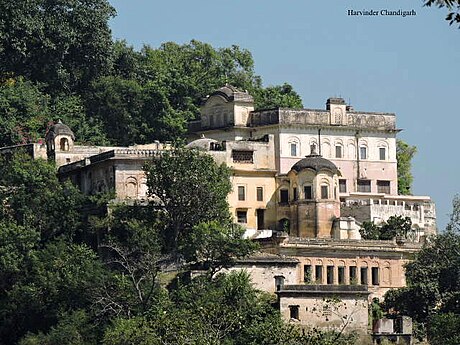The Nepal–Sikh war was a small conflict in 1809 between the forces of the Western Province of Kingdom of Nepal under General Amar Singh Thapa and the Sikh Empire under Maharaja Ranjit Singh.[1][2][3]
This article possibly contains original research. (February 2024) |
| Nepal-Sikh war | |||||||
|---|---|---|---|---|---|---|---|
 Arki Fort in Himachal Pradesh, India | |||||||
| |||||||
| Belligerents | |||||||
|
|
| ||||||
| Commanders and leaders | |||||||
|
|
| ||||||
Background
The confrontation between Nepal and the Sikhs had its genesis in the expansionist policy of the Nepalese mukhtiyar (head of government) Bhimsen Thapa.[4] The Kumaon Kingdom having been incorporated into Nepal in 1791, he endeavoured to add the hill country to its west as far as the river Sutlej. This expedition was entrusted to the Kaji Amar Singh Thapa, who was later reinforced by the Kaji Nain Singh Thapa. In 1807, Kangra Fort, on the west bank of the Sutlej, was put under siege. By early 1809, most of the land of Kangra jagir had been incorporated into Nepal, although the fort still held out. Raja Sansar Chand of Kangra took refuge among the Sikhs in the Punjab.[5]
At first, the Sikh Maharaja Ranjit Singh was reluctant to assist the ruler of Kangra,[6] but a Nepalese push towards the Kashmir Valley changed his mind.[7] Kashmir was effectively an independent territory, riven by Afghan factions and coveted by both Sikhs and Gurkhas. The Sikh ruler dispatched a force which raised the siege of Kangra on 24 August 1809 and forced the Gurkha forces back across the Sutlej. Ranjit Singh then sent a proposal to Amar Singh Thapa to make the Sutlej the boundary between their states. Thapa forwarded the proposal to the Kathmandu Durbar, but Bhimsen Thapa rejected that.
War
The Maharaja recalled Diwan Mohkam Chand from the Kangra expedition in March 1809 and directed him to reach Phillaur. After the settlement of affairs with the British government, Maharaja Ranjit Singh again turned his attention towards Kangra. The Gurkha general Amar Singh Thapa had been at war for quite some time with Raja Sansar Chand in the Kangra valley and had besieged the fort of Kangra. Sansar Chand lost hope for life. Therefore, he sent his brother, Krishan Chand to the Maharaja to seek help. The Maharaja demanded the possession of the fort of Kangra in return for help; to which Sansar Chand agreed. The Maharaja set-out with full preparations and reached Kangra accompanied by a large army by the end of May.[8] All the feudal chiefs were present with their respective militias. According to Munshi Sohan Lal's estimate, there were about ten thousand irregular horse and foot with the Nepalese at that time.[9] The hill Chiefs who were well- acquainted with the routes of the hilly terrain were ordered to block all passages so as to stop all means of procurement of provisions and equipment for the Gorkha army.
Amar Singh Thapa sent a letter to Maharaja Ranjit Singh asking him to surrender and let them keep the fort from his forces and let the Gurkhas capture Kashmir.[10] Ranjit Singh did not accept.[11] The next morning, supply routes of the Gurkha army had been closed by the Sikhs.[11] They waited for ammunition and food of the Gurkhas to run out and after a few weeks the Gurkhas started eating their horses and camels,[12] most Gurkha soldiers died in battle.[13]
The Gurkhas in their mad frenzy of their 'last fight' before death madly ran into the muzzles of the Sikh forces, unplanned.[13] After a month of starvation and bad conditions the Gurkhas made a charge onto the Ganesh Valley,[14] Sikhs conquered the Kangra Fort and fired their superior artillery onto the Gurkhas, massacring them in the thousands.[15] Their bow and arrows could not match to the Sikh cannons, after the gunpowder had finished, 2,000 Sikh cavalrymen attacked the Gurkhas. [15]The remaining forces of Nain Singh Thapa arrived at Guler Fort. The violence ended after some time.[16]
The Maharaja finding an opportune time to drive them out of Guler[16] launched an attack and occupied their positions about a mile (1.06 km.) in front of the fort. A pitched battle ensued. The Gurkhas fought dauntlessly but they had to retreat. Thereafter, they gave a pitched battle near the Satluj where most Gurkhas retreat.[16]
Aftermath
After both side suffered heavy losses, Nepalese retreat from Kangara to the Arki Fort, In exchange for the Sikhs to end eastward expansion past Sangla, which had been where the Gurkhas had retreated past due to Sikh borders encompassing the town of Sangla.[16]
References
Wikiwand in your browser!
Seamless Wikipedia browsing. On steroids.
Every time you click a link to Wikipedia, Wiktionary or Wikiquote in your browser's search results, it will show the modern Wikiwand interface.
Wikiwand extension is a five stars, simple, with minimum permission required to keep your browsing private, safe and transparent.
